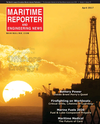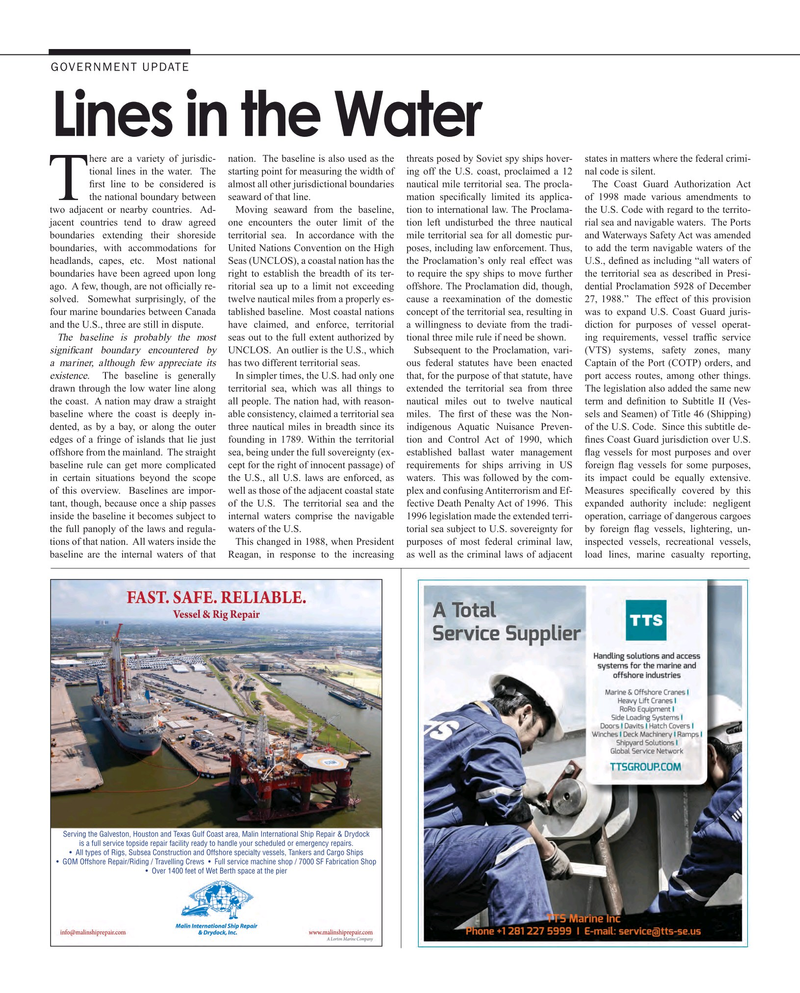
Page 12: of Maritime Reporter Magazine (April 2017)
The Offshore Annual
Read this page in Pdf, Flash or Html5 edition of April 2017 Maritime Reporter Magazine
GOVERNMENT UPDATE
Lines in the Water here are a variety of jurisdic- nation. The baseline is also used as the threats posed by Soviet spy ships hover- states in matters where the federal crimi- tional lines in the water. The starting point for measuring the width of ing off the U.S. coast, proclaimed a 12 nal code is silent.
? rst line to be considered is almost all other jurisdictional boundaries nautical mile territorial sea. The procla- The Coast Guard Authorization Act
Tthe national boundary between seaward of that line. mation speci? cally limited its applica- of 1998 made various amendments to two adjacent or nearby countries. Ad- Moving seaward from the baseline, tion to international law. The Proclama- the U.S. Code with regard to the territo- jacent countries tend to draw agreed one encounters the outer limit of the tion left undisturbed the three nautical rial sea and navigable waters. The Ports boundaries extending their shoreside territorial sea. In accordance with the mile territorial sea for all domestic pur- and Waterways Safety Act was amended boundaries, with accommodations for United Nations Convention on the High poses, including law enforcement. Thus, to add the term navigable waters of the headlands, capes, etc. Most national Seas (UNCLOS), a coastal nation has the the Proclamation’s only real effect was U.S., de? ned as including “all waters of boundaries have been agreed upon long right to establish the breadth of its ter- to require the spy ships to move further the territorial sea as described in Presi- ago. A few, though, are not of? cially re- ritorial sea up to a limit not exceeding offshore. The Proclamation did, though, dential Proclamation 5928 of December solved. Somewhat surprisingly, of the twelve nautical miles from a properly es- cause a reexamination of the domestic 27, 1988.” The effect of this provision four marine boundaries between Canada tablished baseline. Most coastal nations concept of the territorial sea, resulting in was to expand U.S. Coast Guard juris- and the U.S., three are still in dispute. have claimed, and enforce, territorial a willingness to deviate from the tradi- diction for purposes of vessel operat-
The baseline is probably the most seas out to the full extent authorized by tional three mile rule if need be shown. ing requirements, vessel traf? c service signi? cant boundary encountered by UNCLOS. An outlier is the U.S., which Subsequent to the Proclamation, vari- (VTS) systems, safety zones, many a mariner, although few appreciate its has two different territorial seas. ous federal statutes have been enacted Captain of the Port (COTP) orders, and existence. The baseline is generally In simpler times, the U.S. had only one that, for the purpose of that statute, have port access routes, among other things. drawn through the low water line along territorial sea, which was all things to extended the territorial sea from three The legislation also added the same new the coast. A nation may draw a straight all people. The nation had, with reason- nautical miles out to twelve nautical term and de? nition to Subtitle II (Ves- baseline where the coast is deeply in- able consistency, claimed a territorial sea miles. The ? rst of these was the Non- sels and Seamen) of Title 46 (Shipping) dented, as by a bay, or along the outer three nautical miles in breadth since its indigenous Aquatic Nuisance Preven- of the U.S. Code. Since this subtitle de- edges of a fringe of islands that lie just founding in 1789. Within the territorial tion and Control Act of 1990, which ? nes Coast Guard jurisdiction over U.S. offshore from the mainland. The straight sea, being under the full sovereignty (ex- established ballast water management ? ag vessels for most purposes and over baseline rule can get more complicated cept for the right of innocent passage) of requirements for ships arriving in US foreign ? ag vessels for some purposes, in certain situations beyond the scope the U.S., all U.S. laws are enforced, as waters. This was followed by the com- its impact could be equally extensive. of this overview. Baselines are impor- well as those of the adjacent coastal state plex and confusing Antiterrorism and Ef- Measures speci? cally covered by this tant, though, because once a ship passes of the U.S. The territorial sea and the fective Death Penalty Act of 1996. This expanded authority include: negligent inside the baseline it becomes subject to internal waters comprise the navigable 1996 legislation made the extended terri- operation, carriage of dangerous cargoes the full panoply of the laws and regula- waters of the U.S. torial sea subject to U.S. sovereignty for by foreign ? ag vessels, lightering, un- tions of that nation. All waters inside the This changed in 1988, when President purposes of most federal criminal law, inspected vessels, recreational vessels, baseline are the internal waters of that Reagan, in response to the increasing as well as the criminal laws of adjacent load lines, marine casualty reporting,
Serving the Galveston, Houston and Texas Gulf Coast area, Malin International Ship Repair & Drydock is a full service topside repair facility ready to handle your scheduled or emergency repairs. s

 11
11

 13
13
